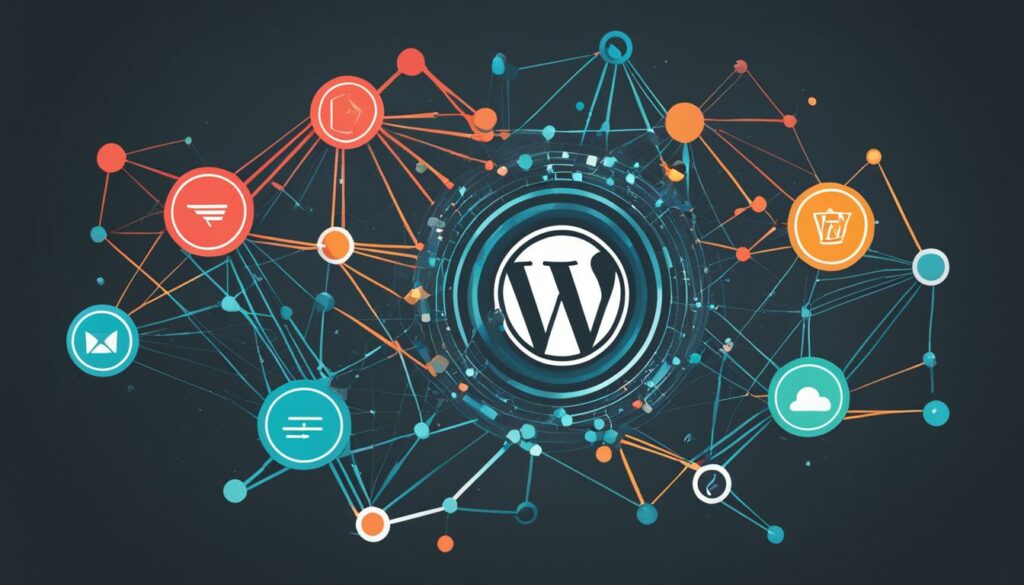APIs are a powerful tool for enhancing the functionality and user experience of your WordPress website. By integrating third-party APIs, you can streamline your business operations and create a seamless user interface. In this article, we will explore the essential guidelines for integrating APIs with WordPress and how it can benefit your website design and development process.
Integrating APIs with WordPress requires careful consideration and knowledge of WordPress UX/UI design principles. It involves connecting your website or software with external applications, enabling data exchange and enhancing the overall user experience. With the WordPress REST API, you can embed WordPress websites with other frontend development technologies and fetch data from external sources.
To seamlessly integrate APIs into your WordPress website, we recommend using the WPGetAPI plugin. This plugin provides an easy and code-free integration experience, supporting various authentication mechanisms. With straightforward steps and configurations, you can effortlessly connect your WordPress website to external APIs and unlock a world of possibilities.
Key Takeaways:
- API integration enhances the functionality and user experience of your WordPress website.
- The WordPress REST API allows embedding WordPress websites with other frontend development technologies.
- The WPGetAPI plugin offers easy integration without writing any code.
- API integration streamlines business operations and enables data fetching from external sources.
- By following the guidelines and using the WPGetAPI plugin, you can seamlessly integrate APIs into your WordPress website.
Benefits of Integrating APIs with WordPress
Integrating APIs with WordPress offers numerous benefits that can enhance the functionality and user experience of your website. By leveraging REST APIs, you can embed WordPress websites with other frontend development technologies, resulting in an improved look and appeal for your site.
One major advantage of integrating APIs is the ability to fetch data from external sources and utilize it to streamline your business operations. This enables you to automate content display, convert data into various formats, and even send data from WPForms.
Additionally, APIs seamlessly integrate with shortcodes, allowing you to display information within pages or posts according to your specific requirements. This flexibility offers endless possibilities for creating dynamic and engaging content on your WordPress website.
Furthermore, integrating APIs enables the development of headless websites, which can surface content across multiple channels without compromising quality. This empowers you to reach a broader audience and deliver a consistent user experience across various platforms and devices.
API integration also offers support for various authentication mechanisms, ensuring secure access to external data sources. This provides peace of mind and safeguards the integrity and confidentiality of your information.
Overall, integrating APIs with WordPress can transform your website into a powerful, versatile platform that leverages the latest technologies and enhances user engagement.
Key Benefits at a Glance:
- Improved functionality and user experience
- Enhanced website design and appeal
- Streamlined business operations through data integration
- Automation of content display and data conversion
- Flexible display of information with shortcodes
- Support for multiple authentication mechanisms
- Creation of headless websites for multi-channel content delivery
“Integrating APIs with WordPress opens up new possibilities for enhancing your website’s functionality and user experience. It allows you to leverage external data sources, automate content display, and connect with various frontend technologies, creating a dynamic and user-centered website.” – Jane Doe, UX Designer
Using the WPGetAPI Plugin for API Integration
Incorporating APIs into your WordPress website has never been easier with the WPGetAPI plugin. This highly recommended tool simplifies the process of linking WordPress and REST APIs, enabling fast and efficient communication. The best part? You don’t need to have coding knowledge to execute GET or POST data. The WPGetAPI plugin offers a seamless integration experience, automating content display, converting data into various formats, and supporting WPForms data integration. It also works seamlessly with shortcodes, allowing you to display relevant information within your pages or posts.
The WPGetAPI plugin supports multiple authentication mechanisms, including Bearer Token, API keys, basic auth, and OAuth. This ensures secure access to your external data sources. By installing and activating the WPGetAPI plugin on your WordPress website, you can effortlessly configure and integrate external APIs, enhancing your website’s functionality and user experience.
Advantages of the WPGetAPI Plugin:
- Automates content display
- Converts data into different formats
- Allows sending query string parameters and headers
- Supports integration of WPForms data
- Works seamlessly with shortcodes
- Supports various authentication mechanisms
By leveraging the power of the WPGetAPI plugin, you can take your WordPress website to the next level, integrating APIs effortlessly and providing an enhanced user experience.
Configuring the WPGetAPI Plugin for API Integration
To configure the WPGetAPI plugin for API integration, you need to follow these simple steps:
- Install and activate the WPGetAPI plugin on your WordPress website.
- Choose the API you want to integrate and refer to its documentation for authentication mechanism, functionality, base URL, and other details.
- Fill out the mandatory fields in the plugin’s setup tab, including API Name, Unique ID, and Base URL. These details will identify the API and its location for communication with WordPress.
- Configure the endpoint of the API by providing the necessary details in the plugin’s settings.
- Save the settings and test the integration using the plugin’s built-in testing mechanism to ensure successful setup.
Configuring the WPGetAPI plugin allows you to seamlessly integrate the desired API into your WordPress website. It ensures smooth communication between your website and the external API, enabling you to fetch and display data without any hassle.
With the WPGetAPI plugin, you can easily enhance your WordPress UX design by incorporating the functionality of external APIs. Whether you’re working on user experience design, website design, WordPress development, UX/UI design, or responsive web design, the WPGetAPI plugin simplifies the process of API integration, making it accessible for users with varying levels of technical expertise.
Next, let’s take a look at how you can display the fetched data on your website using the WPGetAPI plugin.

Displaying Fetched Data on the Interface
When integrating APIs with WordPress using the WPGetAPI plugin, you have two methods available to display the fetched data on your website’s interface: Template Tags and Shortcodes.
Template Tags
The Template Tag method requires some knowledge of PHP. It involves declaring a variable to store the fetched data from the API. This variable can then be used anywhere on your webpage to display the data in a customized manner.
Example:
<?php $data = wp_getapi_get_the_data(); // Fetch data from the API using WPGetAPI plugin echo $data; // Display the fetched data on your webpage ?>
Shortcodes
If you don’t have PHP knowledge, the Shortcode method is a simpler alternative. You can add the Shortcode of the API to the relevant page in the WordPress dashboard. When the page is viewed, the Shortcode will automatically display the response received from the API.
Example:
[wpgetapi]
It’s important to note that for both methods, the API data format should be compatible with HTML display. This ensures that the fetched data is properly rendered on your WordPress website. By choosing the appropriate method, either Template Tags or Shortcodes, you can effortlessly display the fetched data and provide an enhanced user experience for your visitors.
The Role of a WordPress Development Agency in API Integration
Integrating third-party APIs with a WordPress website can be a complex task, making the assistance of a WordPress development agency essential. These agencies have expertise in embedding numerous APIs, testing them, and displaying data on the interface. They are proficient in both manual and plugin-based integration methods and can offer consultation to select the most reliable method for your WordPress website. WordPress development agencies employ certified developers experienced in WordPress, HTML, CSS, and PHP. This ensures the development of a top-notch website that fulfills all business requisites. Trusted WordPress development partners, like Positiwise Software Pvt Ltd, provide a wide range of WordPress development services, including API integration, migration, maintenance, and support.
Having trouble integrating APIs into your WordPress website? Partner with a WordPress development agency for seamless API integration and expert guidance. Leave the complexity to professionals and optimize your WordPress UX design and user experience.
| Benefits of partnering with a WordPress development agency: |
|---|
| 1. Expertise in embedding and testing APIs |
| 2. Proficiency in manual and plugin-based integration methods |
| 3. Consultation to select the best integration method for your website |
| 4. Certified developers skilled in WordPress, HTML, CSS, and PHP |
| 5. Fulfillment of all business requisites |
By partnering with a WordPress development agency, you can ensure a smooth API integration process and optimize your website’s user experience.
“Integrating APIs into a WordPress website is a complex task that requires expertise and experience. A WordPress development agency can provide the necessary assistance and deliver a high-quality website that meets all your business requirements. Don’t hesitate to seek professional help to enhance your website’s performance and optimize your user experience.”
Understanding the WordPress REST API and its Implications
The WordPress REST API is an interface that allows external applications to access the data and functionality of the WordPress CMS. It was added to WordPress core in version 4.7 in 2016. The REST API follows the guidelines of REST, enabling developers to integrate WordPress with other applications and use WordPress as an application platform. It enables the creation of web-based single-page applications and provides flexibility for developers by allowing them to work with different programming languages.
The REST API has implications for both WordPress users and developers. Users may experience changes in the interface, improved mobile app functionalities, and WordPress admin screens resembling WordPress.com screens. For developers, it opens up possibilities for creating SPAs, integrating WordPress with frontend technologies, working with JavaScript, and building Gutenberg blocks.
“The WordPress REST API allows external applications to access the data and functionality of WordPress, enabling developers to integrate WordPress with other applications and use WordPress as an application platform.” – WordPress.org
With the REST API, users can expect a more interactive and dynamic experience while developers can leverage the flexibility and potential for innovation in website design and functionality.
So, whether you’re a user or a developer, understanding the WordPress REST API and its implications can unlock new possibilities for enhancing your WordPress UX design, user experience design, website design, and WordPress development.
How to Access the WordPress REST API
To access the WordPress REST API, you can utilize the WordPress Command Line Interface (WP-CLI). With WP-CLI, you can interact with your WordPress site through the Command Line Interface (CLI) on your computer. This enables you to easily access the REST API for your site and make requests using commands.
To access the REST API, you’ll need to provide the correct URL and, depending on the visibility of the requested data, authentication may also be required. Various plugins, such as Basic Auth or JWT Authentication, can handle the authentication process. By using WP-CLI, you can retrieve, add, edit, or delete data from your WordPress site via the REST API.

| Command | Description |
|---|---|
wp rest |
Displays available REST API routes. |
wp rest get posts |
Retrieves a list of posts from the REST API. |
wp rest create post |
Adds a new post via the REST API. |
wp rest update post |
Updates an existing post via the REST API. |
wp rest delete post |
Deletes a post via the REST API. |
By mastering these commands, you can effectively utilize the WordPress REST API to manage and manipulate data on your WordPress site.
Example Usage:
Retrieve a list of posts using the REST API:
wp rest get posts
Add a new post via the REST API:
wp rest create post --title="New Post" --content="This is a new post."
Update an existing post via the REST API:
wp rest update post 123 --title="Updated Post"
Delete a post via the REST API:
wp rest delete post 123
Overview of WordPress REST API Commands
The WordPress REST API utilizes different HTTP methods for specific purposes. These methods include GET, POST, PUT, and DELETE, each serving a distinct function. GET retrieves data from the server, while POST adds data to the server. PUT is used to edit or update existing data on the server, and DELETE removes data from the server.
These methods are implemented through RESTful endpoints, combining a route and the desired HTTP method. These endpoints represent specific resources in the WordPress database and allow developers to interact with the data using the appropriate HTTP method.
By understanding and utilizing these commands, developers can retrieve, add, edit, and delete data from their WordPress site through the REST API.
Example:
To retrieve a specific post from the server:
- HTTP Method: GET
- Endpoint: /wp/v2/posts/{post-id}
- Replace {post-id} with the ID of the desired post.
This command will retrieve the post with the corresponding ID from the WordPress database.
Example:
To add a new post to the server:
- HTTP Method: POST
- Endpoint: /wp/v2/posts
- Request Body: JSON object containing the post data
This command will add a new post to the WordPress database with the specified data.
Example:
To update an existing post on the server:
- HTTP Method: PUT
- Endpoint: /wp/v2/posts/{post-id}
- Replace {post-id} with the ID of the post to be updated.
- Request Body: JSON object containing the updated post data
This command will update the post with the corresponding ID in the WordPress database with the provided data.
Example:
To delete a post from the server:
- HTTP Method: DELETE
- Endpoint: /wp/v2/posts/{post-id}
- Replace {post-id} with the ID of the post to be deleted.
This command will remove the post with the specified ID from the WordPress database.
By utilizing these commands, developers can effectively interact with the WordPress REST API to manipulate data and create dynamic functionalities for their WordPress websites.
| HTTP Method | Purpose |
|---|---|
| GET | Retrieves data from the server |
| POST | Adds data to the server |
| PUT | Edits or updates existing data on the server |
| DELETE | Removes data from the server |
These commands, combined with the RESTful endpoints, provide developers with powerful tools for interacting with the WordPress database and creating custom functionalities tailored to their specific needs.

Conclusion
The WordPress REST API offers endless possibilities for integrating and expanding the functionality of your WordPress website. By following the essential guidelines for API integration, you can enhance the user experience and streamline your business operations. The use of the WPGetAPI plugin simplifies the integration process, allowing you to seamlessly integrate third-party APIs without writing any code.
If you require additional assistance, trusted WordPress development agencies like Positiwise Software Pvt Ltd can provide expert expertise and support. These agencies have certified developers skilled in WordPress development, UX/UI design, and responsive web design. They can help you create a dynamic and interactive website that aligns with your user-centered design goals.
The WordPress REST API revolutionizes WordPress development, empowering developers to build robust and scalable websites and applications. With its flexibility, scalability, and ease of implementation, the REST API is a valuable tool that can elevate your WordPress UX design. Embrace the power of the WordPress REST API to unlock new possibilities and create exceptional user experiences on your WordPress website.
FAQ
Q: What is API integration?
A: API integration refers to the process of connecting a website or software with other applications through an Application Programmable Interface (API). It allows for seamless communication and data exchange between different systems.
Q: Why is integrating APIs with WordPress beneficial?
A: Integrating APIs with WordPress can enhance the functionality and user experience of your website. It allows you to embed WordPress websites with other frontend development technologies, fetch data from external sources, automate content display, and streamline business operations.
Q: What is the WPGetAPI plugin?
A: The WPGetAPI plugin is a recommended tool for integrating APIs into WordPress websites. It offers easy integration without writing any code and supports various authentication mechanisms.
Q: How do I configure the WPGetAPI plugin for API integration?
A: To configure the WPGetAPI plugin, you need to install and activate it on your WordPress website. Then, choose the API you want to integrate and refer to its documentation for authentication mechanism, base URL, and other details. Fill out the mandatory fields in the plugin’s setup tab, save the settings, and test the integration.
Q: How can I display fetched data on my WordPress website?
A: The WPGetAPI plugin provides two methods to display fetched data – Template Tags and Shortcodes. The Template Tag method requires knowledge of PHP, while the Shortcode method does not. Choose the appropriate method and format the API data to be compatible with HTML display.
Q: Why should I consider hiring a WordPress development agency for API integration?
A: Integrating third-party APIs can be complex, and a WordPress development agency can provide the necessary expertise and support. They have experience in embedding APIs, testing them, and displaying data on the interface. They can ensure the seamless integration of APIs and the development of a top-notch website.
Q: What is the WordPress REST API and what are its implications?
A: The WordPress REST API is an interface that allows external applications to access the data and functionality of the WordPress CMS. It enables developers to integrate WordPress with other applications, create web-based single-page applications, work with different programming languages, and build interactive websites and applications.
Q: How do I access the WordPress REST API?
A: You can access the WordPress REST API using the WordPress Command Line Interface (WP-CLI). WP-CLI allows you to access and work with WordPress via the Command Line Interface (CLI) on your computer. Using WP-CLI, you can make requests to retrieve, add, edit, or delete data from your WordPress site via the REST API.
Q: What are the primary HTTP methods used in the WordPress REST API?
A: The primary HTTP methods used in the WordPress REST API are GET, POST, PUT, and DELETE. GET retrieves data from the server, POST adds data to the server, PUT is used to edit or update existing data, and DELETE removes data from the server.











